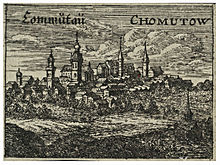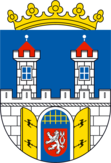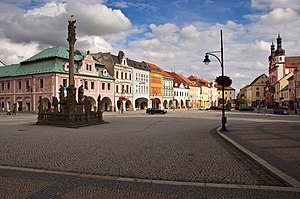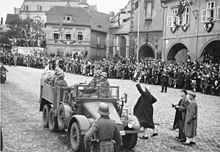Chomutov
| Chomutov | ||||
|---|---|---|---|---|
|
||||
| Basic data | ||||
| State : |
|
|||
| Region : | Ústecký kraj | |||
| District : | Chomutov | |||
| Area : | 2925.3174 ha | |||
| Geographic location : | 50 ° 28 ' N , 13 ° 25' E | |||
| Height: | 340 m nm | |||
| Residents : | 48,720 (Jan. 1, 2019) | |||
| Postal code : | 430 01 - 431 01 | |||
| License plate : | U (old: CV) | |||
| traffic | ||||
| Street: | I / 7 | |||
| Railway connection: |
Prague – Chomutov Ústí nad Labem – Chomutov Chomutov – Cheb Chomutov – Vejprty |
|||
| structure | ||||
| Status: | Statutory city | |||
| Districts: | 1 | |||
| administration | ||||
| Lord Mayor : | Marek Hrabáč (as of 2018) | |||
| Address: | Zborovská 4602 430 28 Chomutov |
|||
| Municipality number: | 562971 | |||
| Website : | www.chomutov-mesto.cz | |||
| Location of Chomutov in the Chomutov district | ||||

|
||||
industrial city of Chomutov ( German Komotau ) was the district town of the former Okres Chomutov in the administrative district Ústecký kraj in the Czech Republic .
Geographical location
The city is located in northern Bohemia , at the crossroads of important railway lines and road connections. It is located in the west of the North Bohemian Basin at the southern foot of the Ore Mountains . The Chomutovka ( Kometau or Komotau ) flows through the village .
history
From the founding of the city to the Middle Ages
Already around 800 there was a small church in the area of the later Komotau. On March 29, 1252, the city of Comotau was donated to the Teutonic Order by Friedrich von Komotau . On February 1, 1261 Přemysl Ottokar II gave the order jurisdiction. At that time the name "Villa Forensis" was still used. From this one concludes that Chomutov was still a village at the time. The order received Krimove in 1281 through a donation from the Kothobor von Retschitz family . At this point in time, the order was already being built. Until the end of the century, the knights received the property at Beßwitz and Otwitz through donations and purchases .
In 1335, the Komotau market was exempted from duties and taxes through a privilege granted by King John of Luxembourg . The city was also given the right to brew beer and hold weekly and annual markets. On October 28, 1396, the Teutonic Order granted the city rights of Komotau to Albrecht von Duben and Nikolaus von Komotau. The city received a town hall and the right to trade in salt , city scales, and seals and city arms .
On October 30, 1407, King Wenceslas IV confirmed the right to the ban mile to the Komotau and thus ended the dispute between the nobility and the bourgeoisie over commercial rights in favor of the cities. On September 21, 1411, the Land Commander of the Order, Ulrich von Ausk, had to cede the rule of Komotau to the royal favorite Stephan von Kobersheim, who was also called Master of Armor. In 1415 Komotau finally went to the Bohemian Crown until 1420, after which it was pledged by Emperor Sigismund of Luxembourg to the Margrave of Meissen . The Hussites took the city on March 16, 1421, the population was then massacred. The Hussite general Jan Žižka ordered only as many to be left alive as were necessary to bury the rest. During the fighting and afterwards about 2500 - according to another source exactly 1363 - people died; In 1424 the town was pledged to Nikolaus I von Lobkowicz ( Mikuláš Chudý ) and later given away. After his death it became the property of Jakob von Wrschowitz . In 1456 Johann Czalta von Kamena Hora became the new lord of Komotau on the instructions of King Ladislaus Postumus . He died four years later and his son-in-law Benedikt von Weitmühl became the new owner. In addition, the city received further privileges from George of Poděbrady (Jiří z Poděbrad). Benedikt von Weitmühl died in 1560 and Ladislaus von Weitmühl and his cousins became the new masters of the city.
From the Middle Ages to the modern age

In 1517, the Komotauer received a letter of freedom from their lords, in which the Jews were forbidden to live, operate a craft or trade in the city, the suburbs and the entire rulership. This privilege against the Jews remained in force until 1848. On August 2, 1525, a large part of the city including the castle burned down. In addition, 70 large books from the library of Bohuslaus Lobkowicz von Hassenstein were burned , including original writings by the Greek sage Plato . In 1529 Sebastian von Weitmühl took over the lands of Komotau. In 1547 the city was attacked and sacked by the armies of the Electorate of Saxony under the leadership of the Saxon Colonel Thumshirm during the Schmalkaldic War . Eight years later the plague broke out and killed 2,300 people; she returned thirteen years later and another 2,500 people died. Alum deposits were discovered in 1556, and mining began in 1558. In 1585 the cooper's guild was established. In 1571 the city was sold to the Lords of Lobkowitz and Hassenstein. In the following years the gentlemen bought back villages and added new ones, such as Rothenhaus , Stadt Katharinaberg and Grüntal, Brandau , Kleinhan , Rudelsdorf and Hasištejn Castle . In 1589 the Jesuits expelled the Lutherans and in the following years built a college to foster Catholic education. On July 2, 1591, riots broke out between Protestants and Catholics in the city . The college was stormed and looted. The main ringleaders were sentenced to death in Rothenhaus and executed on August 20. The town was deprived of all privileges by Popel von Lobkowitz, but granted again two years later, after Georg Popel von Lobkowitz fell out of favor with Emperor Rudolf II and his property was confiscated.
Chomutov bought freedom and in 1606 became a Free Royal City . From 1607 the city had its own magistrate . Looting, contributions , billeting, assaults and rape were the order of the day during the Thirty Years' War . In 1620 the Jesuits were driven out of Komotau again. The college and seminary were sold to the city. After the battle of the White Mountain on November 10, 1620 the city was captured by the imperial troops and forced to take the oath of homage to the emperor and to return the college and seminary to the Jesuits. In 1621 more and more Protestants left the city for Saxony and Meißen . 2500 people died in 1625 from the plague, which returned fifteen years later and claimed another 1000 victims. Six years later on November 12, 1631, the town was captured and sacked by Kaspar von Klitzing (1677–1719), captain of the Order of St. John . March 3, 1662 the foundation stone of the Jesuits' Church of Ignatius was laid.
The bones of St. Victor , given to the Jesuits by Cardinal Salerno in 1725, were buried in a mausoleum in St. In the following years the city bought other goods, including a. Hruschowan . On October 14, 1763, soldiers moved into the monastery during the Seven Years' War . In 1780 the Dominicans took over the Komotau grammar school .
During the Napoleonic Wars in 1805 , Bavarian and French prisoners of war brought lazy fever to the city, which killed over 700 people. From August 21 to 24, 1813, during the Napoleonic Wars, the Three Emperors meeting took place in Komotau , at which the Tsar Alexander I of Russia , the Prussian King Friedrich Wilhelm III. and the Austrian Emperor Franz I. participated.
From industrialization to World War II
From the middle of the century, there were foundations in trade and commerce, but above all in industry, for example the Komotauer Sparkasse and the oldest company in the graphics industry, the Gebrüder Butter book printing company. The railway line Komotau- Dux - Ossegg was opened, later also the line to Eger and the lines of the Buschtěhrad railway to Prague , Weipert or Reitzenhain ( Saxony ) and Brunnersdorf bei Kaaden . The “machine technology college ” was inaugurated. In 1899, the construction of the Komotau dam for the drinking water supply began near Petsch, eight kilometers northwest of the city .
In 1900 the new Gothic style Evangelical Church at the entrance to the city park was inaugurated. In the course of the decades the industry was expanded and communication systems were installed, for example in 1901 the construction of the new water pipe system began. There was also a district hospital, an infirmary , a grammar school and a gym. After October 28, 1918, Komotau was integrated into the newly founded Czechoslovak Republic . Twenty years later, on October 1, 1938, the Sudetenland was annexed to the German Reich and occupied by German troops. Chomutov belonged now to the district Chomutov , Region of Usti nad Labem , in the Reich District of Sudetenland . The Czech minority from Chomutov was then forced to leave the city and the evacuation ended on October 10, 1938.
From the end of the Second World War to the present

After the end of the Second World War , the community came back to Czechoslovakia on May 8, 1945. On May 9, 1945, together with the Red Army, the Czech Revolutionary Guards and parts of the Svoboda Army marched into the city. On June 9, 1945, all 8,000 German-Bohemian men between the ages of 13 and 65 from Komotau and the surrounding villages had to gather at the Jahnsportplatz. According to eyewitness reports, between 12 and 20 of them were shot there, including some members of the Waffen SS . On the following march from Komotau to Maltheuern, some men were also shot because they could not follow the train. The march went along the route: Komotau - Görkau - Rothenhaus Castle - Kunnersdorf - Bartelsdorf - Eisenberg - Gebirgsneudorf - Deutschneudorf (Saxony) - Nickelsdorf - Obergeorgenthal - Niedergeorgenthal - Maltheuern . In 2003 a first memorial stone was inaugurated in Deutschneudorf and a second memorial stone in the main cemetery in Chomutov on September 22, 2007 in memory of this death march .
A legal processing of the event did not take place. Due to the “Amnesty Act” No. 115 of May 8, 1946, such crimes committed until October 28, 1945 remained unpunished. The survivors had to rebuild the bombed hydrogenation plant in Maltheuern, now Záluží. Due to the Beneš decree 108 of October 1945, the property of the German-Bohemian population was confiscated and placed under national administration. The German population was expelled.
Many new citizens from Central Bohemia, Slovakia, repatriates and Roma settled in Chomutov in the post-war period.
Demographics
Until 1945 Komotau was predominantly settled by German Bohemia , which were expelled.
| year | Residents | Remarks |
|---|---|---|
| 1830 | 3,573 | in 547 houses |
| 1845 | 4.014 | in 554 houses |
| 1862 | 4,232 | 42 Protestants and 4,190 Catholics |
| 1890 | 13,050 | including 12,233 German residents |
| 1900 | 15,896 | mostly German residents |
| 1930 | 33,297 | including 4,442 Czechs |
| 1939 | 31,317 | thereof 2,033 Protestants, 27,889 Catholics, 45 other Christians and 17 Jews |
| year | 1970 | 1980 | 1991 | 2001 | 2003 |
|---|---|---|---|---|---|
| Residents | 39.905 | 51,769 | 53,107 | 51.007 | 50,251 |
City structure
No districts are shown for the city of Chomutov. Basic settlement units are Březenecká, Černý vrch, Chomutov-historické jádro, Domovina, Kamenná, Mostecká, Nádraží, Nemocnice, Nové Spořice ( Neusporitz ), Písečná, Pod Březenecki, Pod Březenecki, Podřmedštý, Březeneckéštý, Prážodštý, Prážodštý, Střezodštý, Sadřene vrchem, Prážodštý Šípková, U jezera, U Jitřenky, U Klikara, U Luny, U Michanického rybníka, U nemocnice, U parku, U rasovny, U Severky, U soudu, Za nádražím, Zadní Vinohrady, Zahradní and Zátiší.
The municipality is divided into the cadastral districts of Chomutov I and Chomutov II.
politics
mayor
- 17 ?? - 177? Johann Georg Schlinger
- 17 ?? - 1786 Franz Grönert
- 1786–1798 Peter Ullrich
- 1798–1806 Franz Grönert
- 1807–1838 Jakob Dobrauer von Treuenwald
- 1838–1851 Rudolf Grünwald
- 1851–1859 Johann Georg Löw
- 1860–1872 Josef John
- 1872–1877 Heinrich Schmatz
- 1877–1881 Franz Tschörner
- 1881–1897 / 8? Franz Schreiter
- 1897 / 8–1907 / 10? Anton Schiefer
- 1907/10? –1933 Ernst Storch ( DNP )
- 1933–1937 Administrative Commission / Viktor Herbrich?
- 1937–1938 Viktor Herbrich ( DSAP )
- 1938–1945 Eduard Fiedler ( Sudeten German Party )
- 1946–1947 Václav Strejc
- 1947–1948 Jaroslav Dosoudil
- 1948–1949 Bohumil Dobiáš
- 1949–1950 František Aubrecht
- 1950–1952 Jaroslav Albrecht
- 1952–1953 Jaroslav Třešňák
- 1953–1954 Josef Jakl
- 1954–1956 Bohumil Voldřich
- 1956–1957 František Aubrecht
- 1957-1960 Josef Kincl
- 1960–1970 Jaroslav Chuchel
- 1970–1971 Josef Pavlík
- 1971–1981 Jaromír Franče
- 1981–1989 Václav Šedivý
- 1990–1992 Karel Mrázek ( OF )
- 1993–1998 Bohumil Bocian (nezávislý, později ČSSD )
- 1998–2002 Alexandr Novák ( ODS )
- 2002–2010 Ivana Řápková (ODS)
- 2010–2014 Jan Mareš ( ČSSD )
- 2014–2016 Daniel Černý (Pro Chomutov)
- since December 2016 Marek Hrabáč ( ANO 2011 )
Town twinning
Annaberg-Buchholz in Saxony and Bernburg in Saxony-Anhalt as well as Arenzano in the Italian region of Liguria are twin cities of Chomutov.
Culture and sights
Theaters and museums
- City Theater, Boženy Němcové 552/3
- Kino Svět, Mostecká 5786
- Regional Museum, Palackého 86
- Railway exhibition of the National Technical Museum in Prague
- Křimov Railway Museum
Buildings
The most important cultural and historical buildings are located on the Ringplatz.
- Ring square (Markt, Náměstí 1. máje) with late Gothic town houses and arcades.
- The Church of St. Catherine is the most valuable historical monument in Chomutov and one of the oldest early Gothic buildings in Europe. The church was completed in 1281 as an order church of the Teutonic Order and was part of the castle. Until 1990 the building served as a warehouse. Since November 2000, after more than 200 years, the church has been open to the public again; it is now used as a concert hall and for exhibitions in the regional museum. Once a year it serves as a Catholic pilgrimage church. Right next to it is the former commandery (later the castle), which has been the town hall since 1607.
- The late Gothic hall church of the Assumption of Mary (1518–1542) is the city parish church.
- Immediately afterwards the 53 m high city tower, built after the great fire of 1525 and used as a lookout tower in the summer season.
- Trinity column erected by the sculptor Ambroise Laurentis (1697), surrounded by seven statues of saints (1725–1732).
- St. Ignatius Church ( Jesuit Church ), an early baroque building of the basilica type with a two- tower north facade was built by the Italian Carlo Lurago in the years 1663–1668.
- The “Speicherar” building, originally a Jesuit church (1611) before the St. Ignatius Church was built, now serves as a gallery.
- The district museum (Okresni muzeum v Chomutove) has existed since 1911 and is located in the building of the former Jesuit high school (Jesuit college south of St. Ignatius Church). Exhibitions on the town and regional history as well as the history of the Jews in north-west Bohemia are shown.
- Holy Spirit Church
- Barbarakapelle in Oberdorf
- High school storm
- The alum lake ( Kamencové jezero ) is located north of the city center at the foot of the Ore Mountains and is unique in the world. The lake is about 16 hectares and up to 4 meters deep. The special feature is its content of approx. 1% alum salt . Next to it is the Otvice reservoir .
- The Assigbach-Grundtal (Bezručovo údolí), a 13 km long and up to 200 m deep, wooded valley through which the Assigbach (Chomutovka) flows, is located northwest of the city. In 2002 it was declared a nature park.
- The Komotau Dam (vodní nádrž Kamenička) is located in the valley of the Neuhauser Flößbach (Kamenička) near Blatno.
- On the Hutberg (Vrch Strážiště, 511 m), on the northern outskirts in the direction of Platten ( Blatno ), there is a hotel with a lookout tower (formerly Hutbergwarte, built in 1931 by architect Kugler).
Green spaces and recreation
Sights in Chomutov are the Ore Mountains Zoopark and the Kamencové jezero ( alum lake ).
Sports
- Piráti Chomutov , ice hockey club in the extra league
- FC Chomutov , former second division team
- NSTG Komotau , historical football club
Economy and Infrastructure
Companies
Traditional industries were lignite mining and heavy industry, but also wood processing, the ceramics industry and the textile industry. The world's first seamless tubes were manufactured in the Mannesmann tube factory in 1890. After the First World War , mainly heavy industry was settled, which was replaced by light industry at the end of the 20th century. In Chomutov there were metal processing companies, a clock factory, a chicory factory and the Herold bell foundry. Once upon a time up to 52 large companies were based in the city. The Gelinek paper mill was located on the Assigbach.
traffic
The Chomutov Station is an important railway junction in northern Bohemia. The city of Chomutov is covered by the timetable routes 120 with Žatec , Kladno and Praha (local trains), 130 with Ústí nad Labem (local, express and express trains), 133 with Jirkov , 137 with Vejprty (only two pairs of weekend trains in the summer months with connections in and from Chemnitz ), 140 with Karlovy Vary and Cheb (local and express trains) and 164 with Kadaň předměstí of the ČD state railway . The urban and regional bus transport is operated by the DPCHJ .
Personalities
literature
- Ignaz Krahl : History of the royal city of Komotau . Chomutov 1914.
- Max Türp: The development of coal mining in the Teplitz-Brüx-Komotau lignite mining area . Munich 1975.
- Walter Kult: Memories and stories from the city and district of Komotau . Eschborn 1988.
- Homeland district Komotau (ed.): Expulsion events and legends of the Komotau district . Helmut Preußler Verlag, Nuremberg 1996.
- Homeland Komotau (ed.): Komotauer Jahrbuch , published from 1996 to 2015.
- Contributions to the history of the komotau grammar school . In: Program of the Ober-Gymnasium zu Komotau published at the end of the school year 1871 . Brüx 1871, pp. 1-45 .
- Nikolaus von Urbanstadt : History of the city of Komotau under secular patrons . In: History of the district authority areas Komotau, Saaz and Kaaden. With special consideration of the most important agricultural, industrial and commercial branches (Nikolaus von Urbanstadt, ed.). Volume 5, Komotau 1873, pp. 81-157.
- Viktor Karell : Castles and palaces of the Ore Mountains and Egertal. Vol. 1, Vinzenz Uhl Verlagbuchhandlung, Kaaden , 1935 ("Komotau Castle" pp. 61–64, referring to the castle with the castle church, today the town hall)
Trivia
Because of the many Germans who once lived in Komotau, there is an old Bohemian proverb: "Všude lidé - v Chomutově Němci." ( Everywhere people - Germans in Komotau ).
Web links
- official website of the city of Chomutov (Czech)
- Regional Museum - Town Hall building (Czech)
- German-Czech meeting center in Komotau
Individual evidence
- ↑ http://www.uir.cz/obec/562971/Chomutov
- ↑ Český statistický úřad - The population of the Czech municipalities as of January 1, 2019 (PDF; 7.4 MiB)
- ↑ A comprehensive description of these events can be found in Siegfried Kapper's historical novel Die Glockenstürmer von Komotau (3 vols., Prague 1869/70; summary and assessment of the work in: Oskar Donath: Siegfried Kapper . In: Yearbook of the Society for the History of the Jews in of the Czechoslovak Republic 6, 1934, p. 379 ff. ).
- ↑ Federal Ministry for Expellees, Refugees and War Victims (Ed.): The expulsion of the German population from Czechoslovakia . Vol. 1, 2. Weltbild Verlag, 1994, ISBN 3-89350-560-1 . Vol. 1, page 110
- ↑ Federal Ministry for Expellees, Refugees and War Victims (Ed.): The expulsion of the German population from Czechoslovakia . Vol. 1, 2. Weltbild Verlag, 1994, ISBN 3-89350-560-1 .
- ↑ Yearbooks of the Bohemian Museum of Natural and Regional Studies, History, Art and Literature . Volume 2, Prague 1831, p. 198, point 2) below.
- ↑ Johann Gottfried Sommer : The Kingdom of Bohemia . Volume 14: Saaz District , Prague 1846, p. 147.
- ^ Friedrich Selner: Statistical tables of the Komotau district (Saaz district, in the kingdom of Bohemia) . Prague 1863, p. 22 .
- ↑ KK Statistische Central-Commission (Ed.): Special-Orts-Repertorium von Böhmen . Vienna 1893, p. 294 .
- ^ Meyer's Large Conversational Lexicon . 6th edition, Volume 11, Leipzig and Vienna 1907, p. 339 .
- ^ A b Michael Rademacher: German administrative history from the unification of the empire in 1871 to the reunification in 1990. Komotau district. (Online material for the dissertation, Osnabrück 2006).
- ^ Rudolf Hemmerle : Sudetenland Lexicon . Ed .: Adam Kraft Verlag. 2nd Edition. tape 4 , 1985, ISBN 3-8083-1163-0 , pp. 245 .
- ↑ http://www.czso.cz Czeski Urząd Statystyczny
- ↑ http://www.uir.cz/zsj-obec/562971/Obec-Chomutov
- ↑ http://www.uir.cz/katastralni-uzemi-obec/562971/Obec-Chomutov
- ↑ 'Puč' na chomutovské radnici. Novým primátorem je Marek Hrabáč z ANO. www.lidovky.cz, December 14, 2016, accessed January 3, 2018 (Czech).
- ↑ Website about the NTM depot Chomutov
- ↑ http://www.chomutov-mesto.cz/de/sehenswurdheiten
- ↑ Herbert Herold: The bell foundry and metal goods factory HEROLD in Komotau, Cuvillier Verlag, Göttingen, 2003, 69 pp.
- ↑ Theodor Schäfer: North Bohemia (Meinholds Führer), CC Meinhold & Sons, Dresden 1912, p. 341







